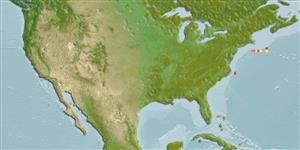>
Perciformes/Cottoidei (Sculpins) >
Liparidae (Snailfishes)
Etymology: Psednos: Greek, psednos, -e, -on = rare (Ref. 45335); barnardi: Named for Keppel Harcourt Barnard who first described the genus Psednos (Ref. 42989).
More on author: Chernova.
Environment: milieu / climate zone / depth range / distribution range
Ecología
marino batidemersal; rango de profundidad 750 - 1368 m (Ref. 42989). Deep-water
Northwest Atlantic: near southeast slope off New England, USA.
Tamaño / Peso / Age
Maturity: Lm ? range ? - ? cm
Max length : 3.4 cm SL macho / no sexado; (Ref. 42989)
Short description
Morfología | Morfometría
Radios blandos dorsales (total): 39-41; Vértebra: 47. No coronal pore, 6 preoperculo-mandibular pores, small eye (18% HL), gill slit 1.6 eye diameter, short mouth (cleft reaching to below anterior margin of eye). Caudal part of body unpigmented, skin on chin and lower jaw black.
Life cycle and mating behavior
Madurez | Reproducción | Puesta | Huevos | Fecundidad | Larva
Chernova, N., 2001. A review of the genus Psednos (Pisces, Liparidae) with description of ten new species from the north Atlantic and southwestern Indian Ocean. Bull. Mus. Comp. Zool. 155(10):477-507. (Ref. 42989)
IUCN Red List Status (Ref. 130435)
Threat to humans
Harmless
Human uses
Más información
Nombres comunesSinónimosMetabolismoDespredadoresEcotoxicologíaReproducciónMadurezPuestaAgregación para la puestaFecundidadHuevosEgg development
Age/SizeCrecimientoLength-weightLength-lengthLength-frequenciesMorfometríaMorfologíaLarvaDinámica larvariaReclutamientoAbundanciaBRUVS
ReferenciasAcuiculturaPerfil de acuiculturaRazasGenéticaElectrophoresesheritabilidadEnfermedadesProcesamientoNutrientsMass conversion
ColaboradoresImágenesStamps, Coins Misc.SonidosCiguateraVelocidadTipo de nataciónSuperficie branquialOtolitosCerebrosVisión
Herramientas
Special reports
Download XML
Fuentes de Internet
Estimates based on models
Preferred temperature (Ref.
123201): 3.1 - 3.9, mean 3.6 °C (based on 5 cells).
Phylogenetic diversity index (Ref.
82804): PD
50 = 0.5000 [Uniqueness, from 0.5 = low to 2.0 = high].
Bayesian length-weight: a=0.01000 (0.00244 - 0.04107), b=3.04 (2.81 - 3.27), in cm total length, based on all LWR estimates for this body shape (Ref.
93245).
Nivel trófico (Ref.
69278): 3.2 ±0.5 se; based on size and trophs of closest relatives
Resiliencia (Ref.
120179): Alto, población duplicada en un tiempo mínimo inferior a 15 meses (Preliminary K or Fecundity.).
Fishing Vulnerability (Ref.
59153): Low vulnerability (10 of 100).
